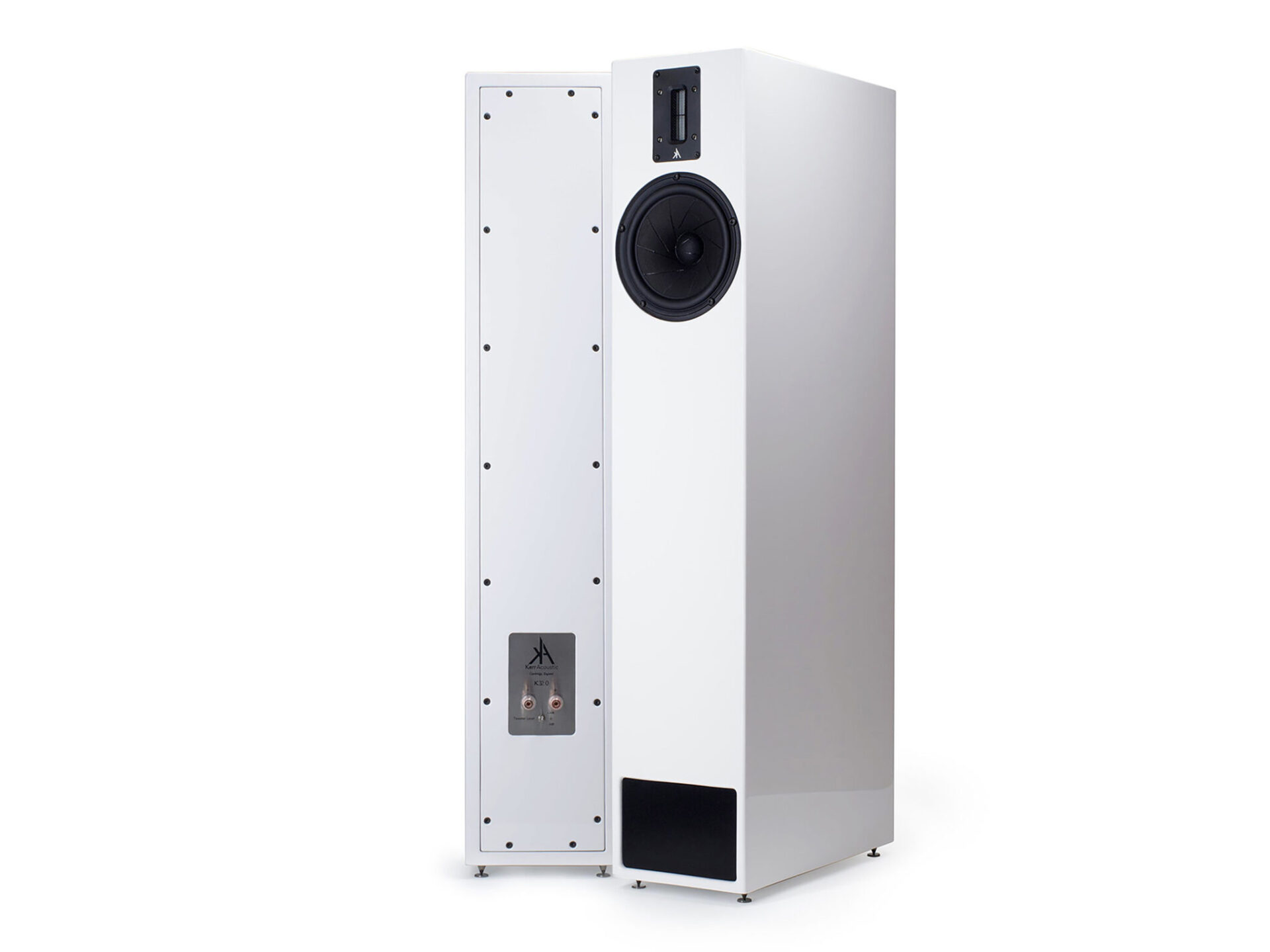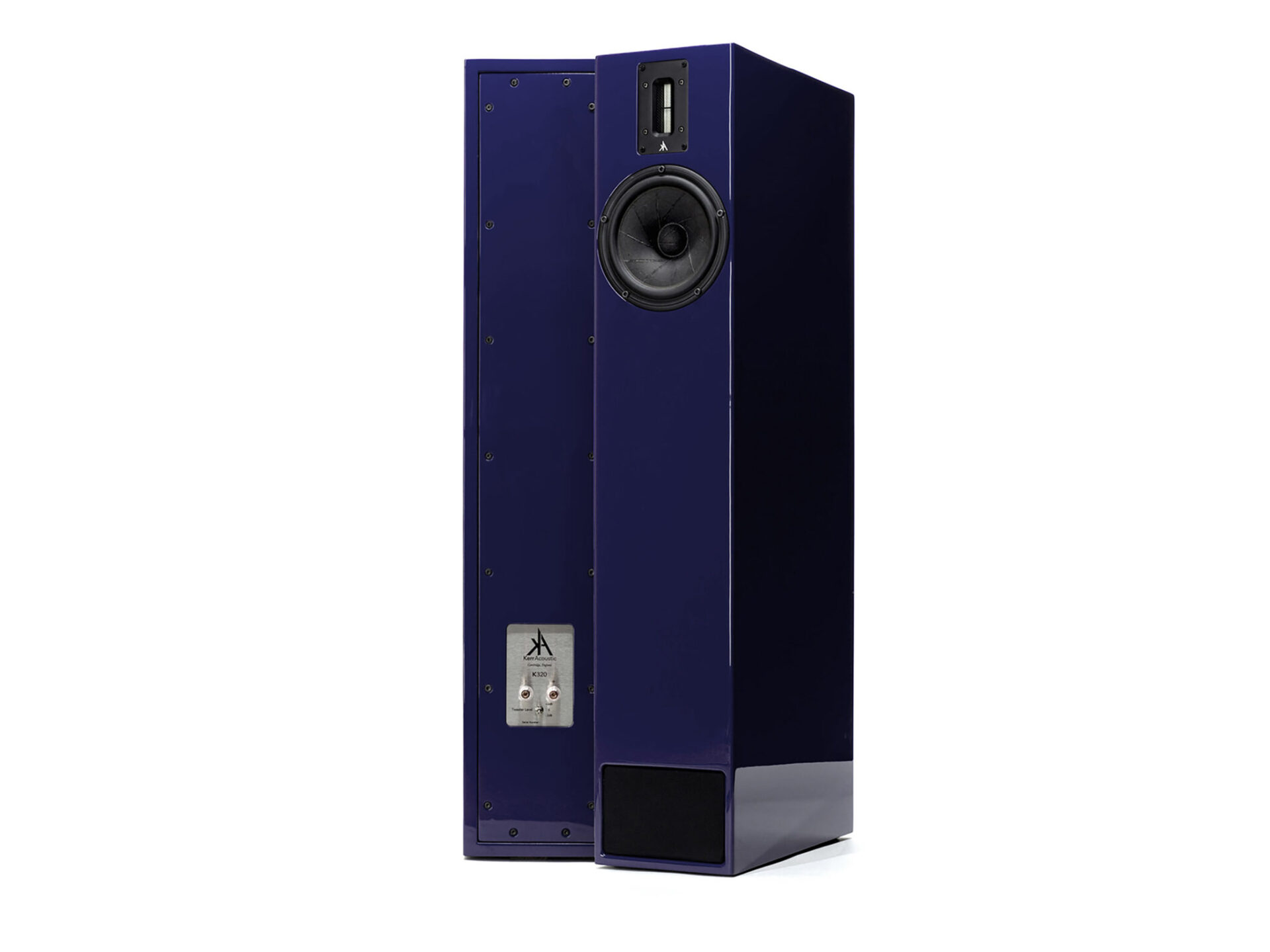Coming in from under the radar is a loudspeaker manufacturer. Kerr Acoustic was a complete unknown until I suddenly saw a picture of a Kerr speaker on social media.
The floorstander reminded me of a PMC speaker, only with a ribbon tweeter instead of a 25 mm dome tweeter. The open port at the bottom of the front suggested transmission line. This was to prove true. And enough to pique my curiosity.
A quick Google search gave me more info: Kerr Acoustic is a fairly new UK manufacturer of speakers for studio and professional use, and until recently has never been seen in hi-fi shops. Compared to well-known manufacturers like Bowers & Wilkins and Klipsch, they’re almost just starting out, but they’ve already managed to make a name for themselves.
You still won’t find Kerr in very many stores, but that may soon change. For these are a pair of very interesting speakers that I strongly recommend driving far to hear.
The one we’re looking at here, the Kerr Acoustic K320 MK3, is a revised version of Kerr’s smallest floorstander. It’s similar to the PMC Twenty5 24i, which is one of the best floor-standing speakers in its class.
There is also a smaller bookshelf speaker called the K300 MK3 and a larger floorstander called the K100 MK2 from Kerr. The current one is sort of in between the two, but there’s also a new model called the K102 on the way. Which is a three-way floorstanding model with two 12-inch woofers and thus more expensive than the K100 MK2.
But it also competes in a completely different class.

Transmission line and ribbon tweeter
The floorstanding K320 MK3 sneaks in at just under €10,000 per pair and costs almost twice as much as a pair of PMC Twenty5 24i. The price puts it in the same class as the Audiovector R3 Arreté – Lyd & Billede’s 2019 Speaker of the Year – and the very well-made Burmester B18.
But the Kerr speaker does something the others can’t. It goes deeper and louder than all three and has the widest range from bass to treble. This has been achieved by creating a 2.4-metre maze-like transmission line. That is, a channel that carries bass below 100 Hz a long way out of the cabinet until it ends up in the port on the front.
A transmission line is very effective even in small cabinets because you can “extend” the bass range this way and get deeper bass out of the speaker.
At the other end is Kerr’s ribbon tweeter, which has a 60 mm diaphragm with neodymium magnets, weighing only 0.027 grams, and extending an octave beyond normal tweetes. The bass and parts of the midrange, i.e. everything below 1950 Hz, are handled by a 165 mm Scan-Speak Revelator woofer with a wood fibre diaphragm.

Place them (almost) where you like
The pictures suggest the cabinets are veneered MDF, but they’re actually made from Baltic beech, which is more expensive and finer than wood veneer usually is. The speakers are available in more colours than shown in the pictures, and customers can choose from a wide range.
As the speakers are not very bulky, they are easy to accommodate. They can be placed close to the back wall without getting excessive bass, but I recommend angling them a little inwards so that the highest notes reach the ears at the same time as the rest of the frequency range.

They go all the way
As I said, they go exceptionally deep. And loud. When I plugged them in, I got the impression that they extended so deep that a subwoofer is unnecessary, at least. The bass on James Blake’s “Limit to Your Love” threatened to strip the carpet from the floor, and loose objects began to shake.
A few days later, the first listening session was set up and confirmed the impression from day one: these speakers play deep bass in a way that very few other speakers can. You almost have to hear them to understand how surprisingly cool it is.
A transmission line is not a replacement for a woofer, but an aid to woofers, giving them greater range. So those who think that the transmission line provides more punch and dynamics in the bass range from 50 to 200 Hz are wrong. That’s the job of the driver itself, and the Scan-Speak Revelator bass does an excellent job of dynamics in the lower frequencies.
Under one condition.
I found that the speakers needed an amplifier with more torque than a 60 watt Hegel H95 has. With the 250 watt Hegel H390, everything was much better. The speakers opened up, the bass came through much better in the soundstage, and there was suddenly much better control over dynamics.
I also tested the speakers with the super-potent Rotel Michi X5, which with 350 watts of power to each channel and a capacitor capacity of 88,000 μF can drive the vast majority of speakers with ease.
It should be noted that it’s not about power, but control. A 50 watt tube amp like the Audio Research I/50 or Naim Uniti Star with 70 watts of power can work just fine. Because it’s not the sensitivity that’s the problem.

Turn up the volume
With the amplification in place, it’s just a matter of sitting down and picking out your favourite tracks. There’s no need to buckle up, because this isn’t a speaker that’s going to run the listener over with massive dynamics and ditto sound pressure.
At first they may seem a little withdrawn, but that’s only until you turn up the volume to a decent listening level. Then you notice that they get all the octaves of the piano down to the very lowest notes. That alone is a revelation, especially if you’re used to smaller speakers.
If you crank the volume knob a bit, the dynamic contrast increases as well. Then you can hear how great the contrast is between the strings and the double basses in the overture to Verdi’s Nabucco, and how sensitively Keith Jarrett actually plays in the first part of his Cologne concerto. The piano sound is extremely fine-meshed and sharply focused, with serious weight in the lower frequencies. You can tell the speakers have a tape disco, because the sounds hang weightlessly from the upper octaves down.
If I have to put my finger on something, it’s that I prefer a little more energy in the midrange. Because I miss hearing Bryn Terfel’s baritone rendered with the sonorous warmth that I get from the Burmester B18. For some, that’s a matter of taste, but I also like that Steve Winwood’s distinctive vocal has the entire sonic spectrum clearly defined. On the Kerr speakers, the vocals sound a little thinner than on the Audiovector R3 Arreté.
Strings sound exquisitely defined with exceptionally fast dynamics that create great contrast in the music. Add to this the ability of the speakers to make the larger strings sound truly like full members of the orchestra, and you realise that these are very rare speakers. I can’t remember hearing such powerful deep bass from such a small speaker before.
This ability gives the music a foundation that positively affects the rest of the frequency range – and other instruments than just double basses and organ tones, for that matter.
The deep bass, although not felt all the time, is an important part of the soundstage of many instruments, so when it’s not there, something is missing from the instrument sound. It’s something you don’t really miss until you’ve first heard it, and after a demo of the K320 MK3 it can be hard to go back to the limited frequenciy range of the speakers at home.

Conclusion
Unknown to us until now, the Kerr Acoustic K320 MK3 are an exceptionally well-made pair of speakers that approach perfection. Especially for those who miss a seamless bass reproduction right down to the twenties with the effect it can have on the music.
But that’s not all they’re capable of. The woofers and transmission line are well integrated, with a uniquely open and airy ribbon tweeter, where the only thing we miss is a little more timbre warmth on individual vocals.
If you have a potent enough amplifier to bring the Kerr speakers to life, you could end up with a pair of easily placeable floor-standing speakers that can provide years of enjoyment. In a complete full-range perspective.

We think
Deep bass gives the music an extra dimension. Very successful ribbon tweeter with razor sharp focus. Beautiful wooden cabinet and flexible placement. A lot of power is needed before they open up. Restrained dynamics until you turn up the volume.
9500 €
Specifications
- Type: 2-way floorstanding speaker
- Woofer: 16.5 cm fibre diaphragm
- Tweeter: 60 mm ribbon tweeter
- Sensitivity: 90 dB
- Impedance: 6 ohms
- Frequency range: 24 Hz – 45 kHz (-6 dB)
- Crossover frequency: 1950 Hz, 12 dB/octave
- Dimensions and weight: 102 x 19.5 x 39.5 cm / 25 kg
- Finish: walnut, oak, rosewood, coloured lacquer
- Web: kerracoustic.com


I really like this music system. and i got it.